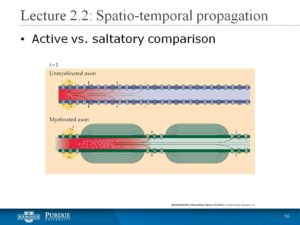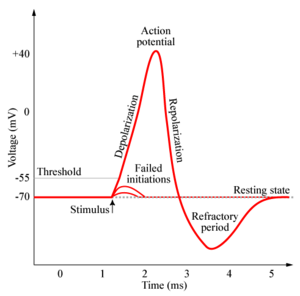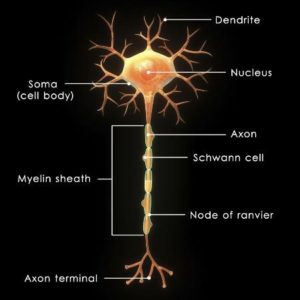Organisms respond to changes in their internal and external environments (AQA A2 Biology) PART 4 of 9 TOPICS
|
Nerve impulses:
For AQA, you only need to know the structure of a motor neurone which is below.
The resting potential is where the membrane permeability differentiates Na+ and K+ ions so that at any given time there are more Na+ ions in the tissue fluid than in the axon with more K+ ions in the axon than in the tissues fluid. This is done when Na-K pump (or sodium-potassium pump) actively transports the ions up their electrochemical gradient (concentration gradient) where for every 3Na+ ions are pumped out, 2K+ ions are pumped in. The build up of K+ ions inside the axon allows the ions to go down their electrochemical gradient (concentration gradient) by facilitated diffusion through the K+ ion channels. There are not many Na+ ion channels meaning not many Na+ ions can diffuse into the axon by facilitated diffusion. This makes the tissue fluid more positive relative to the axon. The membrane is said to be polarised and the potential difference across the membrane is about -70mV (millivolts).
Depolarisation is where a stimulus causes the Na+ gated channels to open and K+ ion gated channels to remain close. NB: K+ ion channels and K+ ion gated channels are two different channels that do similar roles but are used in different situations. They should not be confused over. K+ ion gated channels can be referred to as K+ ion channels but if a question did say K+ ion gated channels then it should not cause confusion. My advice would be to use K+ ion gated channels for depolarisation and K+ ion channels for resting potential. This same tip goes for Na+ ion channels and Na+ ion gated channels. This causes Na+ ions to diffuse into the axon by facilitated diffusion down their electrochemical gradient (concentration gradient) making the axon more positive relative to the tissue fluid. The membrane is said to be depolarised and the potential difference across this axon now is about 35mV. At first only a few Na+ ion gated channels open but when the threshold is met (about -55mV) many more Na+ gated ion channels open and there is a bigger chance of an action potential (impulse) to occur depending on how big the stimulus is. This is passed along the axon in one way causing more Na+ ion gated channels to open.
Repolarisation occurs after depolarisation where the K+ ion gated channels open and Na+ ion gated channels are closed causing K+ ions to diffuse in by facilitated diffusion down their electrochemical gradient (concentration gradient) into the axon. This causes the potential difference to drop as these potassium ions diffuse out the K+ ion channels when there is a high concentration inside the axon. However the K+ ion gated channels remain open for too long making the potential difference to drop below -70mV.
The last stage is the refractory period where it restores the resting potential by closing both the Na+ ion gated channels and K+ ion gated channels as they are ‘recovering’. Only the Na-K pump (sodium-potassium pump) is used as well as the K+ ion channels to get the potential difference back up to -70mV.
The wave of impulses are discrete (It is not a continuous flow) because of the refractory period making the Na+ ion gated channels and K+ ion gated channels closed. This is also the reason why the impulse travels in one direction and limits the frequency of impulse transmission.
Myelinated neurones (neurones that have Schwann cells wrapped around its axon) transmit impulses quicker than non-myelinated neurones. This is because the signal jumps from node to node known as saltatory conduction where depolarization occurs only at the nodes of Ranvier. In non-myelinated axons the whole of the axon must be depolarized. As well the axon being myelinated or not myelinated affecting the speed of conductance, there are two other factors that affect the speed of conductance too:
- Diameter of the axon: The bigger the diameter of the axon the faster the speed of conductance. This is because there is less friction with the walls of the axon.
- Temperature: The higher the temperature the faster the rate of conductance. This is because there is a faster rate of diffusion into the axon of sodium ions.



